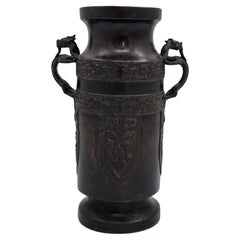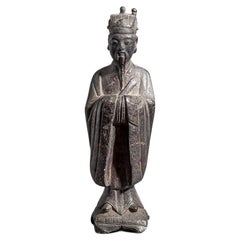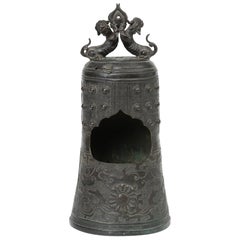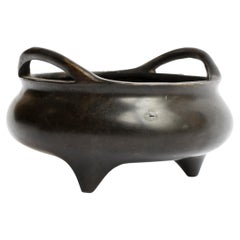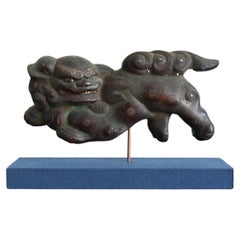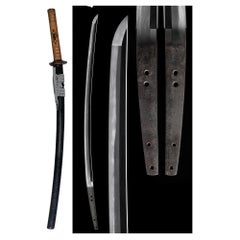16th Century Metalwork
10
to
1
6
4
10
10
10
137
872
793
32
431
175
42
42
14
22
10
10
8
17
9
2
1
10
8
2
2
1
9
6
2
2
1
Period: 16th Century
Ming Dynasty Bronze Vase ( 1368- 1644 )
Located in Hoddesdon, GB
Chinese Ming dynasty bronze vase ( 1368- 1644 ) A genuine Ming vase dating from the early to middle of the ming dynasty. Archaistic decoration...
Category
Chinese Antique 16th Century Metalwork
Materials
Bronze
Korean Antique Bronze Footed Vessel with Lid Early Joseon Dynasty
Located in Atlanta, GA
A bronze bowl shape vessel with fitted lid from Korean dated to 15-16th century (early Joseon Dynasty). In an elegant minimalistic form with thin wall and supported by a high foot ri...
Category
Korean Other Antique 16th Century Metalwork
Materials
Bronze
Collection of Three Korean Antique Bronze Bowls
Located in Atlanta, GA
A collection of three bronze bowls from Korean dated to 14-17th century (late Goryeo to early Joseon Dynasty). It consists of an early example with a slight curvy wall and a high foo...
Category
Korean Other Antique 16th Century Metalwork
Materials
Bronze
Antique 16th Century Islamic Safavid Al Jazari Combination Locking Brass Casket
Located in Portland, OR
A highly important engraved Islamic combination locking brass casket, based on a design by the 12th Century Arab inventor & artist Ismail Al Jazari. Circa...
Category
Iraqi Islamic Antique 16th Century Metalwork
Materials
Brass
16th Century Chinese Standing Bronze Figure of a Nobleman
Located in Hudson, NY
Hongzhi Period (1487 - 1505) sculpture of an important man, possibly Confucius. Comes with box.
Category
Chinese Antique 16th Century Metalwork
Materials
Bronze
Chinese Bronze Bell Shaped Censer Mounted With Buddhistic Lions
Located in Bishop's Stortford, Hertfordshire
An unusual Chinese bronze censer of bell shape mounted with two Buddhist lions probably Ming 1368-1644. The censer is formed as a hollow bell with a wide rounded base and is decorate...
Category
Asian Ming Antique 16th Century Metalwork
Materials
Bronze
Large Himalayan Inlaid Bronze Vajra with Wrathful Faces, 15th-16th Century
Located in Austin, TX
A large and unusual Himalayan bronze and mixed metal nine prong vajra featuring wrathful faces. In the style of the Tangut (Western Xia) Kingdom (1038 to 1227), but probably later, most likely 15th-16th century.
The body of the vajra crafted from a copper alloy, with five wrathful faces on either side and gold and silver inlays to the center. The prongs crafted of iron, with each side having eight prongs arcing outwards around a central prong before coming back to a copper alloy point.
The vajra is meditational tool...
Category
Mongolian Antique 16th Century Metalwork
Materials
Gold, Silver, Bronze, Iron
Antique Japanese Iron Stirrups with Silver Inlay Signed
Located in Atlanta, GA
A pair of antique Japanese Abumis, stirrup for horse-riding, in cast iron with elaborate silver inlay, circa 16th century Muramachi to Momoyama period. The prototype of Japanese abum...
Category
Japanese Japonisme Antique 16th Century Metalwork
Materials
Silver, Iron
Very Exceptional Almost Identical Pair of Bronze Buddhas
Located in Schellebelle, BE
Two bronze Buddhas, Ayutthaya, 16th century, Thailand
with great patina
dimensions
26 cm X 13 cm X 8 cm
24 cm X 14 cm X 8 cm.
Category
Antique 16th Century Metalwork
Materials
Bronze
Fragment of Bronze Head of Buddha, Thailand
Located in Schellebelle, BE
Fragment of Bronze Head of Buddha
Thailand
16th Century
Category
Thai Antique 16th Century Metalwork
Materials
Bronze
Related Items
Chinese Bronze Tripod Censer with Strap Handles, c. 1900
Located in Chicago, IL
For many centuries, people in China have burned incense in shallow censers such as this, placed within a shrine or atop a home altar. An essential element o...
Category
Chinese Qing 16th Century Metalwork
Materials
Bronze
Six Antique Chinese Cloisonne Enameled Rice Bowls C1920
Located in Big Flats, NY
Six Antique Chinese Cloisonne Enameled Rice Bowls with Floral Design, C1920
Measures - 1 @ 4'' x 2''; 5 @ 2.5''H x 4.5''
Category
Chinese 16th Century Metalwork
Materials
Metal
18th Century Chinese Qing Bronze Duck Incense Burner Sculpture
Located in Haddonfield, NJ
18th century Chinese bronze duck incense burner, Qing period
Please note that one foot is missing, broken off, see detailed image.
Category
Chinese Qing Antique 16th Century Metalwork
Materials
Bronze
Chinese Archaisit Cast Bronze Ding Tripod Censer, Early 20th Century, China
Located in Austin, TX
A well cast Chinese archaistic bronze tripod censer, ding, in the Ming style, Republic Period, early 20th century, China.
Heavily cast in the arc...
Category
Chinese Archaistic 16th Century Metalwork
Materials
Bronze
Large Late Qing Dynasty Chinese Cast Bronze Buddhistic Foo Lion Censer
Located in Austin, TX
A large and powerfully cast Chinese bronze censer in the form of two Buddhistic lions, Qing dynasty, late 19th century. The censer is well cast with a strong sense of movement, featuring a pair of fierce Buddhistic lions playfully antagonizing each other. Locked in a mock battle, the smaller lion...
Category
Chinese Qing Antique 16th Century Metalwork
Materials
Bronze
Japanese Bronze Vessel with Dragon Handles and Falcon Lid
Located in Greenwich, CT
Japanese bronze vessel with pair of dragon handles, falcon lid, birds in landscape and elephant heads base.
Category
Japanese Meiji Antique 16th Century Metalwork
Materials
Bronze
Densatil Gilt Bronze Caryatid Figure, Tibet, 15th Century
Located in Austin, TX
A heavy and solidly cast, richly gilt, bronze caryatid figure from Densatil Monastery, Central Tibet, early 15th century or earlier.
Cast in the form of two four armed figures standing back to back in tribhanga (thrice bent position) on a lotus platform, this piece would originally have served as a pillar for a larger seated deity...
Category
Tibetan Tibetan Antique 16th Century Metalwork
Materials
Bronze
Archaic Bronze Censer
Located in Somis, CA
A small rare archaistic Chinese bronze censer. Raised on four tiny feet, the rectangle form with chamfered corners, both sides featuring what appear to be stylized dragons within squ...
Category
Chinese Qing Antique 16th Century Metalwork
Materials
Bronze
Collection of Ten Chinese Ceremonial Poles
Located in London, by appointment only
A fine set of ten polished brass ceremonial spears each with different and unusually elaborate symbolic spear heads representing good fortune, power and strength, long life, accomplishment. One of the few conventional spears is a rare Chinese spear with the double crescent moons either side of a elongated spear head. A Guan Dao...
Category
Chinese Qing Antique 16th Century Metalwork
Two green glazed figures, Ming dynasty (1368-1644)
Located in seoul, KR
Statues of Chinese dignitaries crafted from terracotta, featuring glazes in green and ocher, are set on rectangular bases. The wide-sleeved robes and craftsmanship, along with the cy...
Category
Chinese Ming Antique 16th Century Metalwork
Materials
Pottery
Vintage Large Scale Tang Dynasty Bronze Horse Sculpture
Located in Kilmarnock, VA
Midcentury large scale Tang Dynasty horse done in patinated bronze. I've seen smaller versions of this sculpture but this is the first large version, the detail and patination are to...
Category
16th Century Metalwork
Materials
Bronze
Silver Bronze Censer with Pheasants Incense Burner
Located in Somis, CA
A beautiful 4-lb silver bronze tripod censer. The vessel is decorated to the bulbous sides with three regal pheasants set against a textured feath...
Category
Qing 16th Century Metalwork
Materials
Bronze
Previously Available Items
Rare Japanese Copper Lion Ornament/1500-1650/Engraved Copper Figurine
Located in Sammu-shi, Chiba
We have a unique Japanese aesthetic sense.
And only we can introduce unique items through our purchasing channels in Japan and the experience we have gained so far, in such a way th...
Category
Japanese Other Antique 16th Century Metalwork
Materials
Copper
Katana in Koshirae, Muromachi Period, 1572, NBTHK Hozon Tōken
Located in Milano, IT
Katana in koshirae
Signed: Bishu Osafune Sukesada Saku
Dated: Genki 3 Nen 8 Gatsuhi*
-
Muromachi Period, 1572
-
NBTHK Hozon Token
-
Measures: ...
Category
Japanese Antique 16th Century Metalwork
Materials
Iron
1500-1650 Japanese Antique Copper Cast Buddha Statue / Wall Hanging Decoration
Located in Sammu-shi, Chiba
We Japanese introduce unique items with unique aesthetics, purchasing routes and methods that no one can imitate.
This is what is called a hanging Buddha. (Called kakebutu in Japan)
A hanging Buddha is a cast of a disk and a Buddha statue, and was hung at a temple.
It can be said to be one of the genres of Japanese cultural properties.
And this Kakebutsu is believed to date from the 16th century to the beginning of the 17th century.
In other words, it is from the latter half of the Muromachi period to the beginning of the Edo period.
Originally it was gold, but the color has faded and turned black to copper.
However, this Buddha statue still has gold.
It is rare for gold to remain, indicating that it is in good condition.
The name of this Buddha statue is "Yakushi Nyorai...
Category
Japanese Other Antique 16th Century Metalwork
Materials
Copper
H 14.18 in W 14.18 in D 2.37 in
Katana, Osafune Kiyomitsu
Located in Milano, IT
Katana, Osafune Kiyomitsu
Mumei, Osafune Kiyomitsu
Late Muromachi Period (1392-1573), circa 1560
-
NBTHK Hozon Token
-
Nagasa [length]: 74.3 cm
Sori [curvature...
Category
Japanese Antique 16th Century Metalwork
Materials
Iron
Japanese Bronze Buddhist Water Bowl from the Momoyama Period
Located in Prahran, Victoria
Japanese bronze water bowl which has led a previous life within a Buddhist temple, possibly as a vessel offering water for the cleansing of many hands, or perhaps placed at a doorway, providing nurture to a passing bird or animal. It would happily find it's place and tell it's story within your courtyard, or at your front door, sing it's song to all who pass, your favourite flowers adrift on the water it holds in it's lotus shaped arms.
From the Momoyama period...
Category
Japanese Antique 16th Century Metalwork
Materials
Bronze
Wakizashi Samurai Short Sword Tsunahiro School Circa 1550-1650 by Tsunaie
Located in Soquel, CA
Superb and precious Samurai Wakizashi Sword with superior mountings and Shirasaya. With crests of the Hikone-Tachibana (Ii-clan) on the sword Habaki (sword collar) (The Ii became pow...
Category
Japanese Antique 16th Century Metalwork
Materials
Wrought Iron
Japanese Samurai Helmet 'Kabuto' Signed "Soshu-Ju Myōchin Jo", Momoyama Period
Located in Milano, IT
A 32 iron-plate samurai helmet (sujibachi kabuto) decorated with silver "nunomezogan choji-karakusa" with a clove and ivy motif.
The four cardinal plat...
Category
Japanese Antique 16th Century Metalwork
Materials
Iron
H 11.82 in W 15.75 in D 9.85 in
Ming Dynasty Iron Figure of a Standing Guanyin
Located in Torino, IT
The figure has been cast in iron. There are traces of polychrome red lacquer that was highlighting the robe, and the petals of the double lotus base.
Ming Dynasty (1368-1644), China.
Guanyin is known to be the female bodhisattva of infinite compassion and mercy to East Asian Buddhism. Her full name is Guan Shi Yina; Guan means to observe, watch, or monitor, Shi means the world, Yin means sounds, specifically sounds of those who suffer. Thus, Guanyin is believed to be a compassionate being who watches for and responds to the people in the world who cry out for help. To be compassionate is the supreme Virtue of Mahayana Buddhism. She is also associated with vegetarianism, being an act of compassion toward animals. Guanyin was introduced to China as early as the 1st century AD and spread to Japan through Korea soon after Buddhism was first introduced into the country in the mid seventh century. Historically, the worship of Guanyin was represented as the male Indian Bodhisattva Avalokitesvara, who is portrayed as a healer to the sick and injured. When the worship of Avalokitesvara migrated into China it was worshiped in its masculine form. Since Avalokitesvara is considered to be the personification of compassion and kindness, and these traits are associated with the Chinese concept of Yin, the feminine aspect of creation, the representation of Avalokitesvara in China metamorphosed to an all female form around the twelfth century due to Taoist influence on Buddhism. Avalokitesvara has the largest number of forms and is the most popular Buddhist deity. Guanyin is thought to be neither male or female but in accordance with the lotus sutra the body can take on any form necessary to relieve suffering.
In a modern period, Guanyin is to be depicted as a beautiful woman wearing a white flowing robe (white representing purity) who brings wealth and children made by her devotees. This depiction derives from the earlier Pandaravaisni also known as Padmapani in the sanskrit from. The name Padmapani means "born of the lotus", the lotus leaf symbolizing purity, peace, and harmony. Along with the white flowing robe, Guanyin is also often shown wearing necklaces or adornments of Indian and or Chinese royalty...
Category
Chinese Ming Antique 16th Century Metalwork
Recently Viewed
View AllMore Ways To Browse
Arabic Pot
Asian Round Brass Tray
Meiji Plaque
Antique Copper Tray Round
Japanese Iron Teapot
Copper Incense Burner
Iron Japan Teapot
Brass Incense Burner Antique
Shang Dynasty Bronze
Stirrup Japan
Cloisonne Incense Burner
Antique Vajra
Chinese Brazier
China Brazier
Chinese Antique Censer
Tibet Bell
Cast Iron Teapot
Cloisonne Horse
